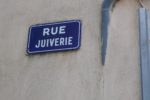 Saint-Paul-Trois-Châteaux, an ancient city in southeastern France that boasts a splendid 12th century Romanesque church, medieval town walls and gates and a cobblestoned downtown of considerable charm, can also lay claim to unique vestiges of a small Jewish community that abided there for three centuries or so before the saw the anti-Semitic writing on the all and got out while the going was good.
Saint-Paul-Trois-Châteaux, an ancient city in southeastern France that boasts a splendid 12th century Romanesque church, medieval town walls and gates and a cobblestoned downtown of considerable charm, can also lay claim to unique vestiges of a small Jewish community that abided there for three centuries or so before the saw the anti-Semitic writing on the all and got out while the going was good.
There was a small but consistent population of Jews in the city from the 12th century well into the 15th. They were ghettoized into a handful of streets on and around the Rue Juiverie, the street that is still named after them centuries after their departure. As was the custom with these segregated neighborhoods, the residents had a curfew and were locked in at night. Still, bounded on one side by the town market and on the other by bishop’s palace, the Jewish quarter was in the very heart of the city and the 70 or so families who lived there made good.
 We know there was a synagogue in the neighborhood because a 15th century Holy Ark was found in one of the buildings, known as Tower House, in the early 18th century. Dated 1445, the stone archway with wooden doors was where the synagogue’s Torah scrolls were kept. It is a unique survival, the only one of its kind in France and is now on display in the local archaeological museum.
We know there was a synagogue in the neighborhood because a 15th century Holy Ark was found in one of the buildings, known as Tower House, in the early 18th century. Dated 1445, the stone archway with wooden doors was where the synagogue’s Torah scrolls were kept. It is a unique survival, the only one of its kind in France and is now on display in the local archaeological museum.
To the marked advantage of the Jewish community, the town wasn’t part of France in the Middle Ages. It was ruled by the Holy Roman Empire, so yes,while they were locked in at night and subject to a number of discriminatory laws and practices, at least they didn’t have to deal with repeated expulsions, confiscations and a wide variety of oppressive measures ordered by French kings like Philip II, who was just 17 years old when he kicked out the Jews and stole their stuff in 1182, and Louis IX who set copies of the Talmud on fire by the thousands, made usury illegal and forced Jews charged with the newly criminal offense to pay huge sums in support of the Crusades and turned the Inquisition up to 11. They even managed to dodge the mass expulsion edict of 1394 when all the Jews in France were forced to leave the country by order of King Charles VI.
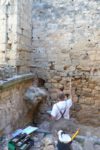 Provence was absorbed into France in 1481. Initially it seemed like Jews in the province, which had deeply rooted Jewish communities going back to the 1st century A.D., might be okay. Their privileges were confirmed in 1482. But de jure and de facto are two very different things, and in 1484 waves of anti-Semitic violence broke out regularly. Provencal Jews, recognizing the stench of pogrom approaching, starting packing up and leaving, and the Jews of Saint-Paul-Trois-Châteaux were no exception. Archival records note there were just three Jewish families left in town by 1486, and that’s the last mention of any Saint-Paul-Trois-Châteaux Jews on the historical record.
Provence was absorbed into France in 1481. Initially it seemed like Jews in the province, which had deeply rooted Jewish communities going back to the 1st century A.D., might be okay. Their privileges were confirmed in 1482. But de jure and de facto are two very different things, and in 1484 waves of anti-Semitic violence broke out regularly. Provencal Jews, recognizing the stench of pogrom approaching, starting packing up and leaving, and the Jews of Saint-Paul-Trois-Châteaux were no exception. Archival records note there were just three Jewish families left in town by 1486, and that’s the last mention of any Saint-Paul-Trois-Châteaux Jews on the historical record.
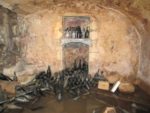 In the 1990s, the city government began to buy properties in the old Jewish quarter with an eye to restoring it and creating a suitable environment to return the Holy Ark to its original context in the Tower House. Archaeologists have been studying the neighborhood since 2014 and have discovered remains going back to Gallo-Roman times. The most recent work has unearthed a flooded cellar that archaeologists believe was a mikveh, a ritual Jewish bath. The city called in experts from France’s National Institute for Preventive Archaeological Research (INRAP) to explore this intriguing find.
In the 1990s, the city government began to buy properties in the old Jewish quarter with an eye to restoring it and creating a suitable environment to return the Holy Ark to its original context in the Tower House. Archaeologists have been studying the neighborhood since 2014 and have discovered remains going back to Gallo-Roman times. The most recent work has unearthed a flooded cellar that archaeologists believe was a mikveh, a ritual Jewish bath. The city called in experts from France’s National Institute for Preventive Archaeological Research (INRAP) to explore this intriguing find.
This small (7 by 4 meters), vaulted and partially buried construction contains a groundwater emergence point. The bath would have consisted of a shallow pool. The construction forms and techniques could correspond to the configurations of Medieval mikvaots.
The building has since been modified several times. The cellar was used to store bottles, for example (the archaeologists collected more than 600 of them), and anomalies suggest a later, more complex, modification. A diverticulum and the existence of a walled, partially masked, opening suggest architectural alterations that were masked by later transformations. They could be the remains of spaces associated with the mikveh and necessary for its functioning (dressing room, stairway access, etc…).
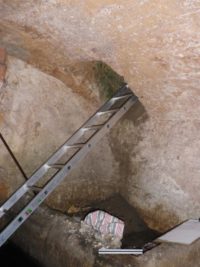
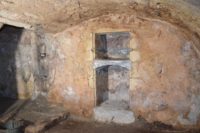
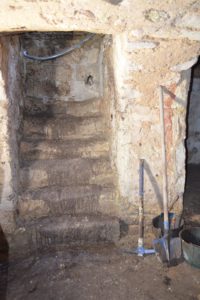
What about those bottles ? 😮
The Grignan-Les Adhemar AOC (* Côteaux du Tricastin) is the northernmost wine-growing AOC in the southern area of the Rhône wine region.
According to the records and archeological finds, wine has been produced in the region since the antiquity.
Unfortunately, there are no records -that I know of- for the ‘mikvehs’ and ‘veh caves’ in all those Juiveries, and there are many.
————————–
(*) Following an accident at the Tricastin Nuclear Power Center in July 2008, when uranium was released, the sale of Coteaux du Tricastin wine decreased. The wine growers therefore wished to change the name of the appellation to something without “Tricastin”, to avoid being associated with the nuclear power plant.
On the picture with the bottles there is what looks like some kind of pottery-ware think on the left, with ribs on top. I wonder what it is?
So fantastically cool! On the second floor the window reminds me of the entrance to Solomon’s Temple with its successively recessed frames. Thank you.
Bernard— Not one hundred percent sure what you meant in statement regarding “records of mikvehs from the Juiveres “. For the record, no ancient/medieval Jewish community would be without a mikveh, just as they would not be without a synagogue
@Susie, my silly remark was mainly a rather ill attempted joke, referring more to the wine depots (“march-vins”) than the ritual baths (“mikvehs”).
I assume that the correct plural is a different one, but are well aware that there was hardly any Jewish community without one.
Furthermore, in almost any medieval town there still is a “Rue Juivery” in which, I assumed, the number of mikvehs and wine depots might be -at least roughly– the same.
Of course, I was unable to tell if this would really count as particularly ‘Jewish’ humour. The storage of uranium, however, would hopefully be a rather local exception.
I am still waiting for an answer to the question I posed a month or so ago regarding the medievel churches in the Jewish quarter in ….. (Forgot where). I asked why the Jews needed two churches. Feeble attempt at humor.
Plural of mikveh in English- mikvehs !!
Plural of mikveh in Hebrew – מקואות !!!
HaHa
I think I see what you did there.
mkw*wt would a lot of consonants, and as additional S’s probably wont really improve the “plural” here, where to put -i.e. speak- the vowels ? Is it “mikwajot” (or something less “feeble”) ?
Unfortunately, I am unable to follow you on your ‘medieval church arithmetics’, though.
Mikvehot
Mik ve ot
Thanks Susi – My ‘vowel distribution’ was pure guesswork. All what I remembered, was that the plurals indeed often seem to end with ‘ot’, but -frankly- I really could not tell, where that came from.
Plurals ending in ot are feminine
Ending in im Are masculine
I dare say ‘Tov’, Susie
So it would be ‘Klezmorim’ –which I suddenly remember having read somewhere– and e.g. ‘Susan(n)ot’ or -with ‘sh'(ot)- ‘Shushan(n)ot’ ? … Or maybe something like ‘Mazelot’, so to speak, ***מַזָּלוֹת lots of (female) stars.
:hattip:
Who knows ? – I might be able to remember that.
I am no scholar but vaguely remember reading that civil and church authorities often put residency requirement on Jews living in certain areas. This sometime included attending sermons! Residents in certain a certain parish often had to pay a tithe to the church weather they attended or not. In modern thinking this is unheard of but to the medieval mind this is logical.
Susie, the establishment of the churches, which may be parish or belonging to a monastery, say, may predate the Jewish community. Just as in modern cities, fresh groups of people move in and replace the previous populations.
Here in Lublin, Poland, Jewish people replaced a significant part of the original population of the old town over the centuries, many of the latter moving out into the new suburbs. The original Catholic parish church remained there until being demolished in the 19th century. The Dominican church remains. Sadly the Jewish people have now mostly/all gone.
Bernard– tov maod! Where is the עברית from?
Scott– hearing church sermons for Jews was mostly a requirement in the inquistion. Back in the Middle Ages everyone who wasnt a farmer or lived in a small village lived in a walled town. Thats pretty much where the Jews were allowed to live so they could be lacked in at night. Precursor of the ghetto.
Trevor– the Jewish population would have moved to the suburbs also if they had been allowed to. I think my ansestor from the 1700’s, Rabbi David Buchner, was from Lublin
Susie,where have you been? I miss your posts.
I’ve seen photos and footage of mikveh’s from the Levant to Limerick reused for other purposes over the years. Tombs, hideouts, beer/wine cellars, spring houses, you name it. If you need a cool underground space, an old mikveh is just the thing.
It happens to many things once the people who made them are gone. One of the finest works of an early large cast bronze legged vessel was discovered in China in the 1970s by an archaeologist who noticed what a farmer was using for a hog trough. The old guy had found and dragged it home a couple of decades before. If it’s functional for the task and people have a need for it, it’s going to be put into service, no matter how old.
Susie, many did indeed move to the suburbs, depending on the era and how much political pull you had I suppose. Many 19th-20th century tenements in the fashionable and less fashionable districts had Jewish occupants.
Lublin is a good place to have ancestors from, it is so worth a visit! :yes:
The side window in my workroom looks out to the entrance of the kibbutz mikveh (they are still used by religious men and women). Thinking about what said above regarding re use ; really got me laughing. Thought I would put up a sign there…. “Beware all you who pass through these portals. In one hundred years time this will be a pub and wine cellar.”
My son who makes beer sure needs an old mikveh!!
Susie, I’ve been a homebrewer on and off since boyhood, when I used to help my Uncle’s and Grandfather brew and make wine.
Tell the young man to buy an old working refrigerator and an after market temp. controller. The entire set-up shouldn’t cost him more than one hundred dollars. The controller will allow him to set the temps inside the refrigerator to between 32F and about 70F. You plug the controller into the wall, the fridge into the controller, slide the wire to temp probe between the door seal and the door and stick the probe on the inside wall of fridge. It takes no tools, no cutting and no rewiring. It makes an old fridge a plug and play “beer cave”.
Isn’t purification via ‘Lautering’ or ‘Läuterung’ what a mikveh, or partially a brewery, is all about ?
‘Lauter bodegas’ in former mikvehs, as likewise mikvehs in former lauter bodegas, would not really surprise me.
Yes, mikvehs have to do with purification. But while ther is no problem is using an ancient mikveh for brew making and storing, the other way around really would not work. Too many religious requirements
‘Stupid’ people could mistake the absence of religion for enlightenment.
However, there is my belief that at least some of the religious provisions and requirements for cleanliness, while others seem to have a point, are what they are ..an illusion.
Or in other words, if they in fact do have a point, their point is obviously a rather different one: The reality is not as ‘clean’.
Sarah you’ve your terms mixed up common mistake as brewers tend to stick with German terms for brewing as their “secret language”.
Lautering is rinsing the mashed grains with hot water to get all the good sugars out to make up the liquor you’re going to add hops to and boil to make the wort you’re going to ferment to make beer.
Lagering comes after fermentation when the beer is stored in a cool to cold place to age and let the flavors come together. It can last anywhere from three weeks to a year depending on the style and strength of the beer.
An old mikveh with some ice brought in during the winter would have been a perfect place to lager beer for local farmers and villagers during the warm months.
Lager also refers to beer yeast type that ferments best in the 45-55 F degree range. Ale yeasts ferment best in the 60-70 degree range. Both ales and lagers can be “lagered” to take off the rough edges. That’s likely how lager yeasts evolved, some strains managed to still slowly ferment while sitting in the cold and their descendants still ferment the lager beers of today.
Thanks for the idea Bruce. But my son says he tried it a while back ad wasntsuccessful. But these days he is rewing on his father in laws roof top terrace and the beer is great. He must be doing something right
Oh well.
Brewing is something it takes a little time and practice to get consistent results from, like cooking.
I used to be a certified beer judge at homebrew competitions. People would say, “That must be great!” Hah! A good third of what you taste runs between the tang of pickle juice and the oily residue of kerosene. The kicker is you’re not allowed to spit it out like wine judges, you’ve got to drink that little cup, stomach turning or not. The only fun thing is reading the other judges notes which are full of comments like, “Is this a stout or shoe polish?”